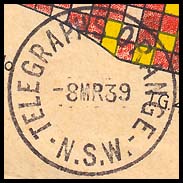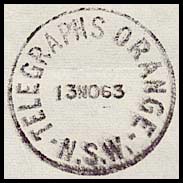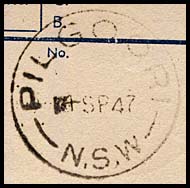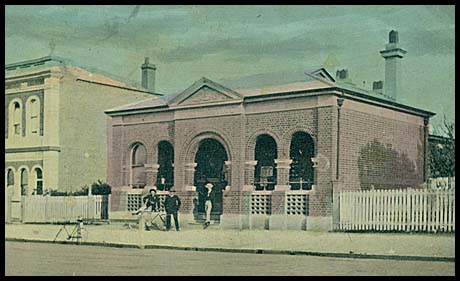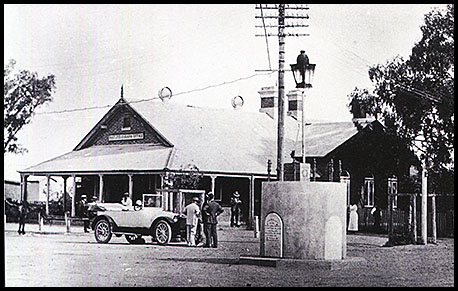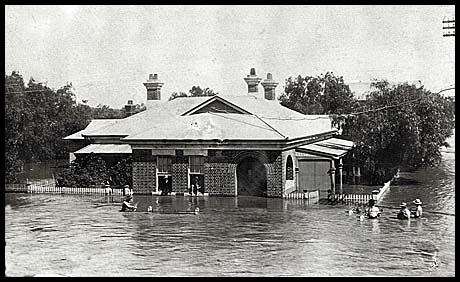Telegraph Offices in the north-central region.
- Home, index, site details
- Australia 1901-1988
- New South Wales
- Overview of NSW
- Telegraph lines
- Telegraph Offices
- Date stamps
- Forms
- Envelopes
- Rates
- Stamps
- Queensland
- Overview of Qld
- Telegraph lines
- Telegraph offices
- Date stamps
- Forms
- Envelopes
- Rates
- Stamps
- South Australia
- Overview of SA
- Telegraph lines
- Telegraph Offices
- Date stamps
- Forms
- Envelopes
- Rates
- Stamps
- Tasmania
- Overview of Tasmania
- General developments
- Reports
- Organisation
- Telegraph lines
- Telegraph Offices
- Date stamps
- Railway lines
- Forms
- Envelopes
- Rates
- Stamps
- Overview of Tasmania
- Victoria
- Overview of Vic.
- Telegraph lines
- Telegraph offices
- Date stamps
- Forms
- Envelopes
- Rates
- Stamps
- Ephemera
- Western Australia
- Overview of WA
- Telegraph lines
- Telegraph Offices
- Date stamps
- Forms
- Envelopes
- Rates
- Stamps
| Bathurst.
A Telegraph Office was opened on 29 December 1859. On 4 January 1860, the Northern Times reported that, as of 30 December "The excitement occasioned in this town by the opening of the telegraph still continues. The telegraph office was crowded all day by persons sending messages and the promptness with which the replies were received has given great satisfaction". It did not, however, combine with the Post Office until 13 November 1905. The Post Office had been opened on 1 March 1828 - one of the earliest in New South Wales. A very full account of the Post Office together with a picture from the right side was written by the Bathurst District Historical Society. Tenders for the erection of the Post & Telegraph Office at Bathurst closed on 2 February 1875. A Telegraph Office was also opened at the Bathurst Racecourse on 24 January 1914 and operated (on race days) only until 1966.
|
 |
|
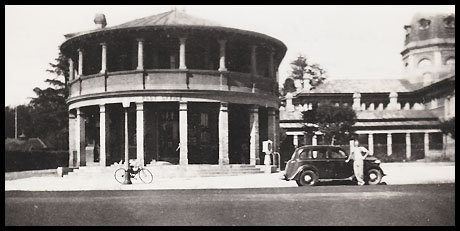 Bathurst Post Office (private photograph but year unknown). |
||
Two types of date stamp were used with telegrams:
|
||
Used: 3 October 1944 to 1965. |
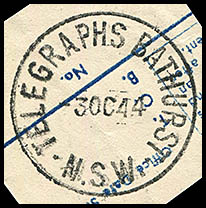 3 October 1944. (Earliest recorded date). |
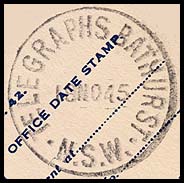 18 November 1945. Used on AB-DO-8H. |
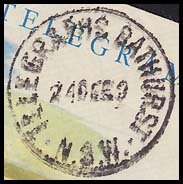 24 December 1959. Used on FDI Xmas envelope (AA-GXE-59). |
||
| Bathurst Railway Station.
A Telegraph Office was also opened at Bathurst Railway Station from 14 September 1894 until it closed in 1971.
No date stamp for explicit use with telegraphic work was issued to Bathurst Railway. The usual postal date stamp may have started as Type 1D (ii), as is suggested by Hopson & Tobin. Clearly revisions were made later but are undocumented. |
 Bathurst Railway Station about 1910. |
The date stamp shown at the right is ike type 2 (ii), has N.S.W at the base but no side arcs and no full stop after the W.
|
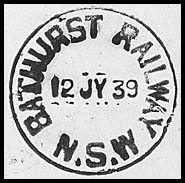 12 July 1939. |
| Bundarra.
The Telegraph Office was opened on 1 October 1874. The Post Office had been opened on 1 January 1852 - well before the Office at Inverell had been opened. In 1934, an example of a Bundarra Post Office date stamp of 1857 was discovered in a deceased estate. It had been made of brass. |
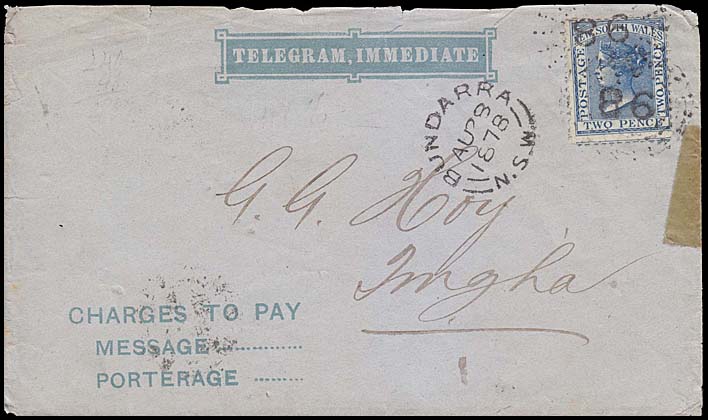 Delivery envelope (NC-EO-4) used at Bundarra on 28 August 1878 with the usual postal date stamp. |
| Condobolin.
The Telegraph Office was opened in 1878 and merged with the Post Office on 21 August 1878. The Post Office had opened on 1 July 1858. Condobolin is 467 km from Sydney.
|
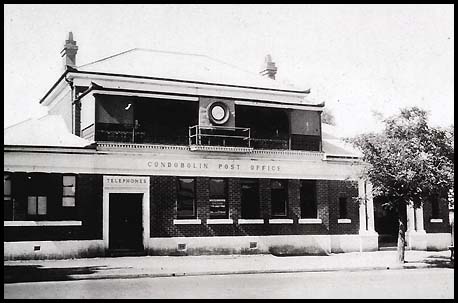 |
||
A rubber circukar TELEGRAPH OFFICE date stamp was issued to Condobolin.
|
 17 December 1964. Used on AA-DO-13B. |
|
|
| Coonabarabran.
The Telegraph Office was opened on 1 May 1875 as a P&T office. The Post Office had opened on 1 January 1850. |
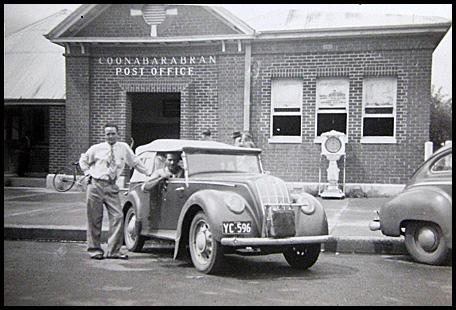 Coonabarabran Post & Telegraph Office about 1950. |
| Coonamble.
The Coonamble Telegraph Office was opened on 20 July 1875 and merged with the Post Office on 1 September 1875. The Post Office had opened on 1 April 1859.
|
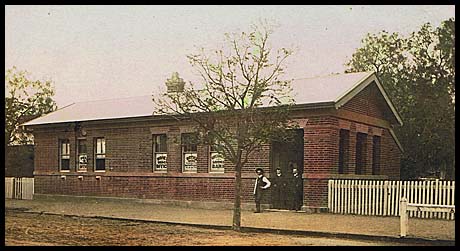 Coonamble P&T office about 1880. |
Tenders were called in April 1979 for the construction of a new Post & Telegraph Office. Clearly the Maitland Mercury (29 June 1879) considered there was a need for a new office:
In February 1881, the Post & Telegraph Office moved into its new building "although no fence had yet been erected between the Post Office yard and the gaol". In October 1885, Mr. W. H. Datson, the telegraph messenger at Girilambone, was appointed to be the telegraph operator at Coonamble. |
|
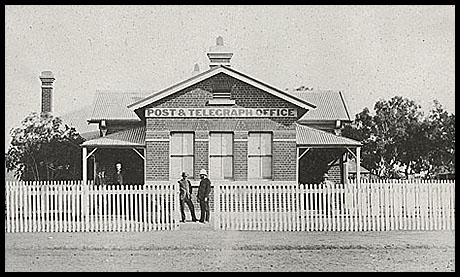 The new Coonamble P&T office in 1884. Source: NSW State Records. |
Source: NSW State Records. |
A steel circular Type 2C TELEGRAPHS COONAMBLE date stamp was used both on telegrams and on ordinary mail.
|
|
 Cover with a Coonamble Telegraphs date stamp of 28 May 1936. The cover commemorates the first air mail flight between Coonamble and Sydney. |
|
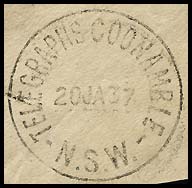 20 January 1937. |
 14 June 1945. Used on an embossed registration envelope. |
|
The Evening News of 6 May 1886 reported that "Arrangements are being made for holding public meetings in the Molong district to agitate for the extension of the railway to Cumnock and also for the erection of a telegraph line to that place". A Post Office had been opened in Cumnock on 1 August 1879. Alas no telegraph station but a Telephone Service at the Post Office was established on 6 February 1891. It enabled telephone and telegraph services to be transacted. For reasons now unknown - except possibly for the realisation of the greater importance of telegraphs - the Telephone Service was replaced with a Telegraph Office on 13 July 1899. |
| Dubbo.
The Telegraph Office was opened on 12 November 1864 and merged with the Post Office on 1 September 1867. In July 1871, a petition was delivered to the Government asking for an assistant to be provided to the Telegraph Master with the duties to look after postal matters. The Post Office had opened on 1 January 1848.
|
 First Dubbo Post & Telegraph Office. |
|
| Somtimes, no matter the quality of the design of the construction, little things can and do go wrong. The Dubbo Liberal of 13 September 1921 reported "The post office clock has not exactly been adopting the go slow habit recently but has actually refused to go at all on two occasions. People who rise with the 6 o'clock chime every morning waited in vain yesterday as the old timekeeper stopped at 4.30 and there were a few who overslept themselves". | 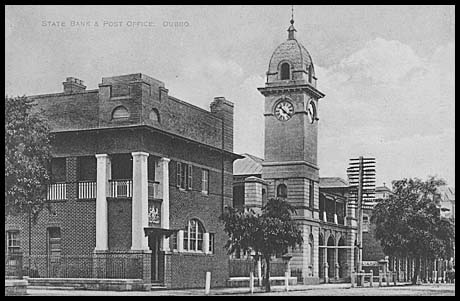 The new Dubbo P&T Office with the State Bank on the left. Note the arches from the front were retained in the renovations. |
|
A ordinary postal type 2A (27 mm) date stamp was used on telegrams from 1915 to 1921. A steel circular type 2C TELEGRAPHS DUBBO date stamp was issed to the Office:
|
Used on AB-GCF-36A. |
Used on AB-GCF-36A. |
The only TELEGRAM slogan cancellation recorded as having been used at Dubbo is TELEGRAMS: SPEEDY, RELIABLE, EFFECTIVE. The only recorded example of its use at Dubbo is on 15 May 1941.
|
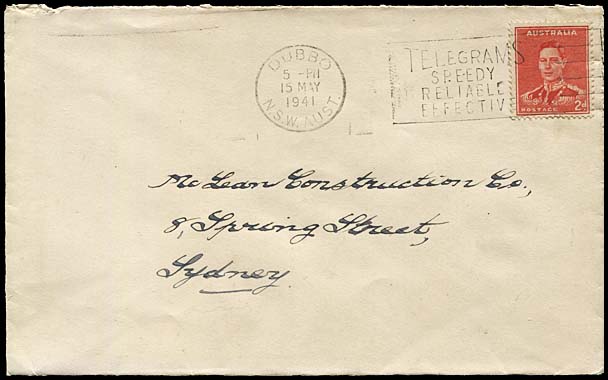 15 May 1941. |
|
|
A Telegraph Office opened on 7 July 1874 while a Post Office had opened on 1 January 1835. These two offices were combined on 15 September 1875. |
|
|
|
A rubber circular TELEGRAPHS date stamp (RC1-T) was issued to the Office:
|
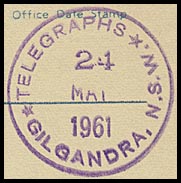 24 May 1961. Used on AW-DO-10 (59). |
 22 October 1963. Used on AA-DO-13C. |
| Inverell.
The Telegraph Office opened on 23 July 1868 and merged with the Post Office on 1 April 1869. The Post Office had first opened on 15 September 1859 when the Post Office responsibility was transferred from Byron (opened 1 January 1855) which was located 11 km away. Tenders for a new building were called in the Gazette of 5 July 1873 after £1,500 had been placed on the Estimates. |
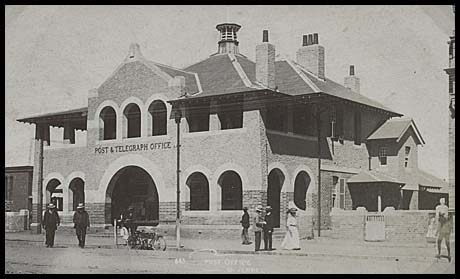 Inverell Post & Telegraph Office soon after construction in 1904. Good collectors have used this Post Office at an early age for purchasing new issue stamps and for picking up telegrams. |
|
 |
19 November 1924.
Usual postal date stamp with |
See similar telegraph humour on postcards elsewhere. |
| Katoomba.
The Telegraph Office opened in 1881. A Receiving Office had been opened at the Railway Station on 1 February 1879 and upgraded to a Post Office on 16 August 1880. The combined Post & Telegraph Office was opened on 19 May 1885 and removed from the Railway Station on 16 August 1885. |
|
The Office was issued with a rare steel circular T. O. date stamp - one of only two Offices to use such a format.
|
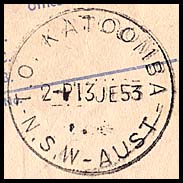 13 June 1953. Used on AW-DO-10 (47BB). |
| Lithgow.
The Telegraph Office was opened 27 February 1877.
|
|
|
The Office was issued with a circular rubber TELEGRAPHS SECTION date stamp (RC1 - TS).
|
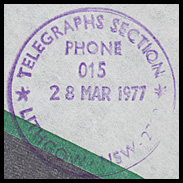 28 March 1977. Used on a Confirmatory delivery window envelope. |
|
| The usual postal date stamp was also used for telegraphic business. | 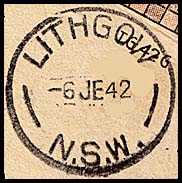 6 June 1942. Used on a Congratulations telegram delivery form. |
|
The Telegraph Office was opened on 29 March 1876 and it merged with the Post Office on 1 August 1877. On 22 June 1879, papers were laid on the Table of the Legislative Assembly concerning the site for a Post and Telegraph office at Molong. |
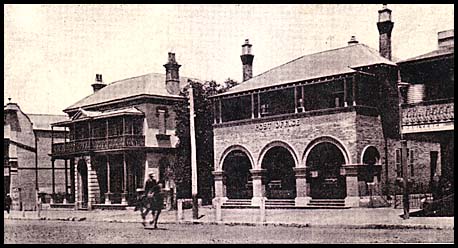 Molong Post & Telegraph Office about 1900. |
| Mudgee.
On 10 December 1861, the Legislative Assembly was informed that tenders had been called for the construction of a Telegraph Office in Mudgee. A Telegraph Office was opened on 16 May 1862 (H&T say 1861) and combined with the Post Office on 1 January 1870. The Ofices were separated on 26 June 1871 but recombined on 1 April 1893. The Post Office had opened on 1 January 1840. A notable event was reported in the Illawarra Mercury of 6 March 1942 - "a boy telegram messenger could not be obtained and so the postmaster appointed, a girl". Not really that long ago. A Telegraph Office was opened at Mudgee Railway Station on 14 September 1894 and it closed in 1915. It was reopened at a date unrecorded but closed again on 31 December 1955. |
.jpg) Mudgee P&T office under construction. Source: Wikipedia. |
||
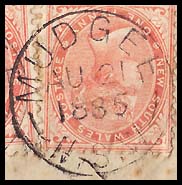 |
 |
||
| Mudgee 21 August 1885. Date stamp type 1D (i) with side arcs and no full stop after W. Used on delivery envelope (NC-EO-3B). |
Mudgee 1 November 1926. Type 2A date stamp with side arcs and no stop after the W. (AB-DO-3D). |
||
| Mungindi.
The Mungindi Telegraph Office was opened on 28 November 1881 and merged with the Post Office on 1 February 1882. The Post Office had opened on 1 April 1867. Mungindi is 780 km from Sydney.
|
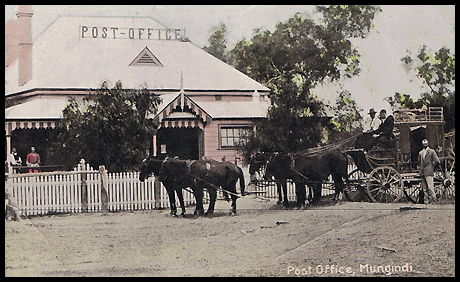 |
||
| Being right on the NSW-Queensland border, Mungindi was singled out as an example of the problem of having special "border rates" for telegram charges. In a debate in the House of Representatives on 24 October 1935, Mr. Nock (Country Party, NSW) said that "the normal 9d rate for 15 miles should not be barred by a State border. The (interstate) charge of 1/4 for telegrams sent just across the Murray River from Wodonga to Albury or from Wahgunyah to Corowa was unreasonable. At Mungindi (Queensland) people had to cross the border to the post office on the New South Wales side of the river, and pay 1/4 to send a telegram back into their own district". | 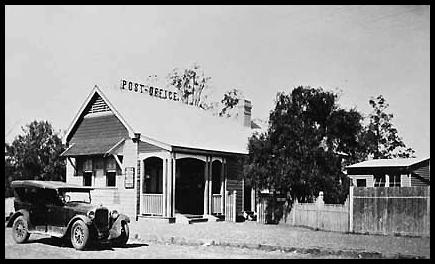 Mungindi Post & Telegraph Office about 1920. |
| Narrabri.
The Narrabri Telegraph Office was opened 8 June 1869 with Mr. R. D. Arnott as the Station Master. It merged with the Post Office on 15 July 1872 - the Post Office having been opened on 1 June 1861. The Maitland Mercury of 2 September 1869 commented: "The telegraph is in full operation and is quite a boon to the people now that our mails depart at such awkward times. We get our Sydney and Maitland letters on Monday and Thursday mornings and the return mail starts out again in a couple of hours which oftentimes makes it awkward to reply by return - hence the use of the telegraph". |
 Note: this picture has been printed in reverse!! The enlargement shows the letters of "POST AND ..." on the façade are reversed. |
|
|
||
"A public meeting was held in the Court House on the 20th instant, with the view of remonstrating with the Government against the proposed amalgamation of the office of Postmaster with that of the Telegraph Station master at Narrabri". For those with a keen interest in this region, the report printed in the Maitland Mercury of 29 October 1869 makes very interesting reading. Two points relevant to this description are:
|
||
A steel circular type 2C TELEGRAPHS NARRABRI date stamp (SC1-T) was issued to the Office.
|
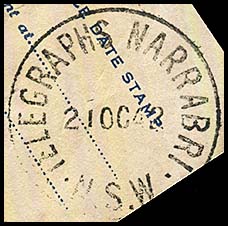 21 October 1942. Used on AB-DO-8H. |
|
| The Narrabri Railway Station also had a telegraph office from 19 February 1883 although over the following 50 years, the name kept changing - Narrabri West, Narrabri West Railway Station as well as the original Narrabri Railway Station. | ||
| Nymagee.
The Post & Telegraph Office was opened on 1 December 1881. No special date stamp was issued for use with telegraphs. |
A steel circular TELEGRAPHS ORANGE type 2C date stamp was used at Orange with two formats. The Hopson & Tobin entry is therefore revised.
|
|
|
|
|
| The usual post office date stamps were also used on telegrams in Orange. |  5 December 1901 Used on 5/- coin stamp design commonly used to pay higher value telegram costs. Date stamp type 1D (i). |
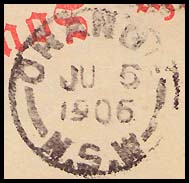 5 July 1905. Diameter: 24 mm. |
T 1908 NI-DO-4Ab.jpg) Orange - usual postal date stamp. 23 October 1908 Used on NI-DO-4. Type 2C datestamp with time (unusual on a telegram). |
|
The Telegraph Office was opened on 17 March 1875 and was upgraded to a Post & Telegraph Office on 1 April 1875. Parkes Post Office opened as Bushman's Lead on 1 August 1872 and changed name to Parkes on 1 December 1873. It had been established in response to the demand for postal facilities from those searching for gold in the surrounding area. Mail had originally come from Forbes but when Cobb and Co took over the mail coach run in 1882, Parkes was in contact with both Forbes and Orange. |
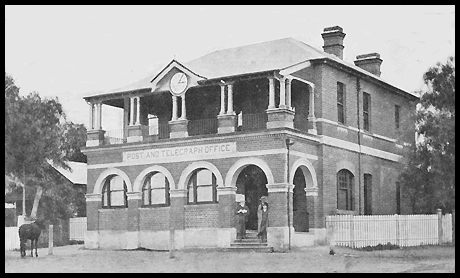 Parkes P&T Office about 1900 - after major alterations and the installation of the exterior clock in 1895. |
| Peak Hill.
The Post & Telegraph Office opened on 31 July 1890. |
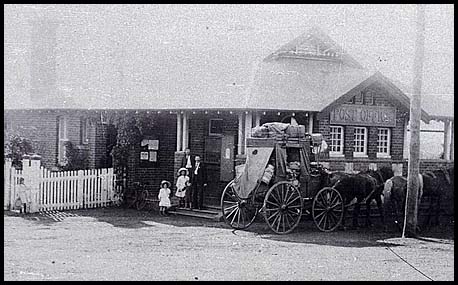 Peak Hill Post & Telegraph Office about 1910. |
|
Located about 25 km from Tamworth. Also spelt Pilgoorie. A Telegraph Office was opened on 7 December 1926. A Telephone Exchange was added on 29 August 1934. The Offices closed on 30 April 1968. Hopson and Tobin record a type 2A date stamp for the office used only in 1959. |
Rated: RRR. |
| Warialda.
The Warialda Telegraph Office opened in a merger with the Post Office on 1 July 1877. The Warialda Post Office had opened on 1 January 1848. A tender was accepted in January 1879 for the erection of a Post & Telegraph office in Warialda. |
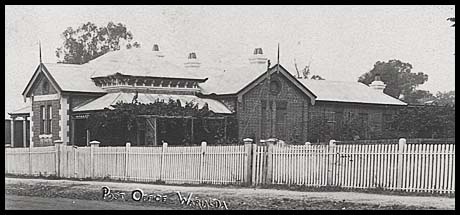 |
||
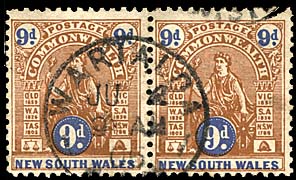 2 July 1905. H&T Type 1D (i). Used on 9d Commonwealth issue |
| Warren.
The Telegraph Office opened on 26 October 1876 and merged with the Post Office (unsure of date as Hopson confused).
|
 |
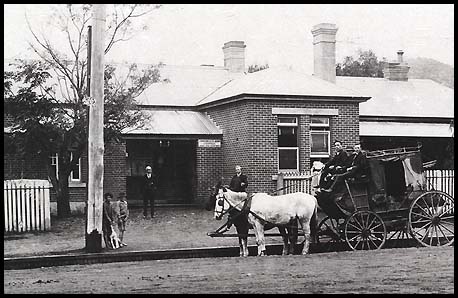

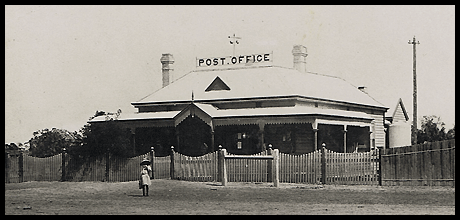
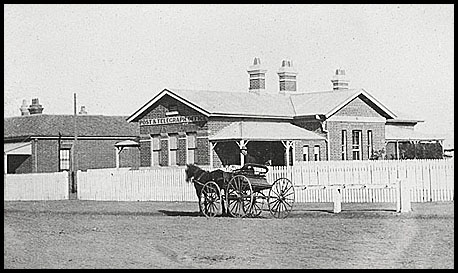
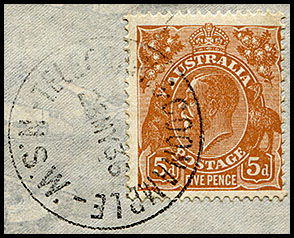
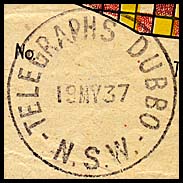

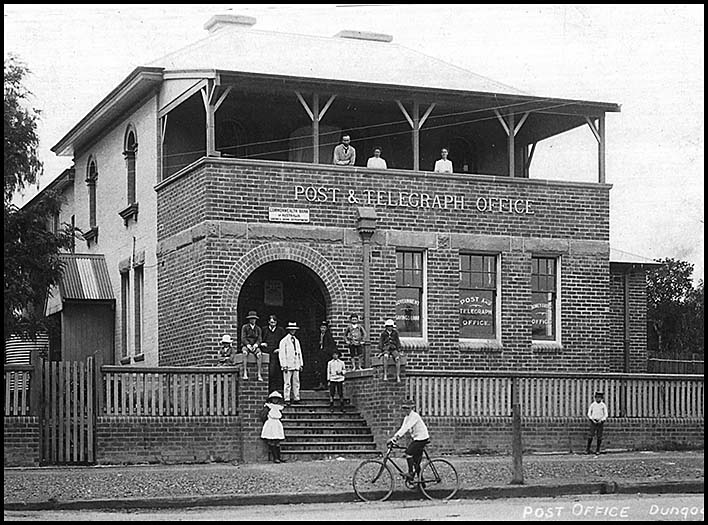



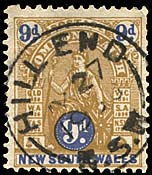
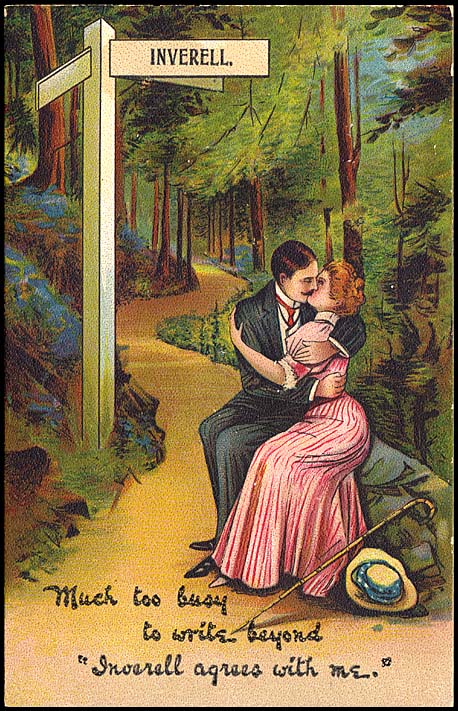
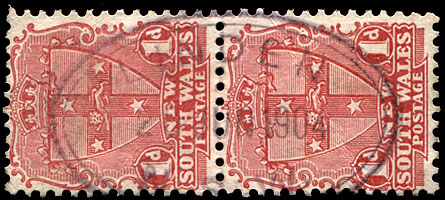

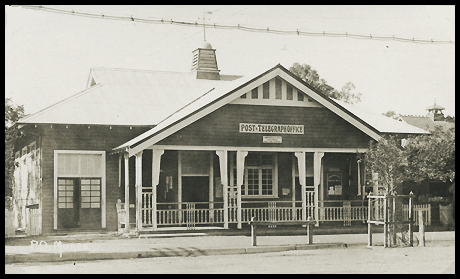

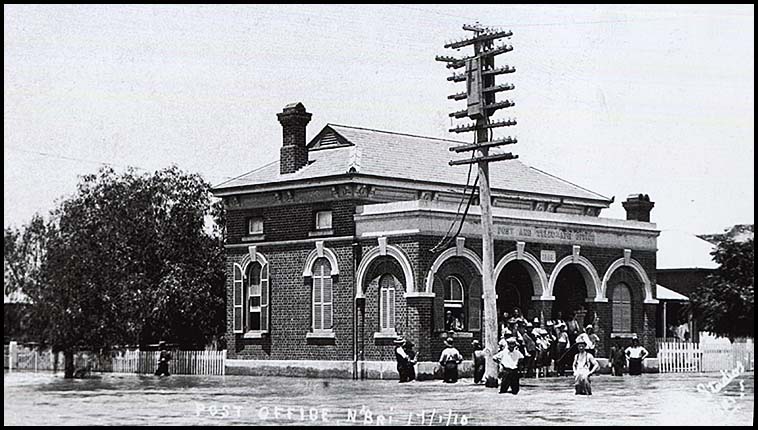
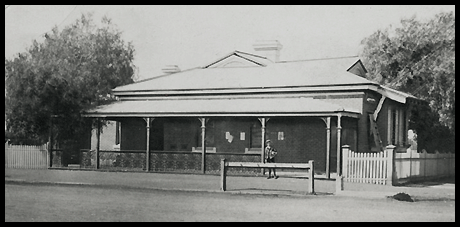 Nyngan Post Office (circa 1900).
Nyngan Post Office (circa 1900).


